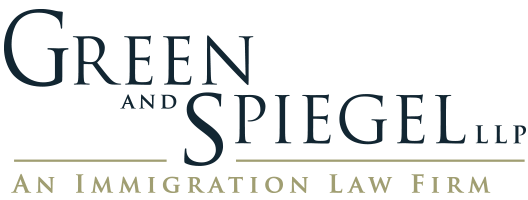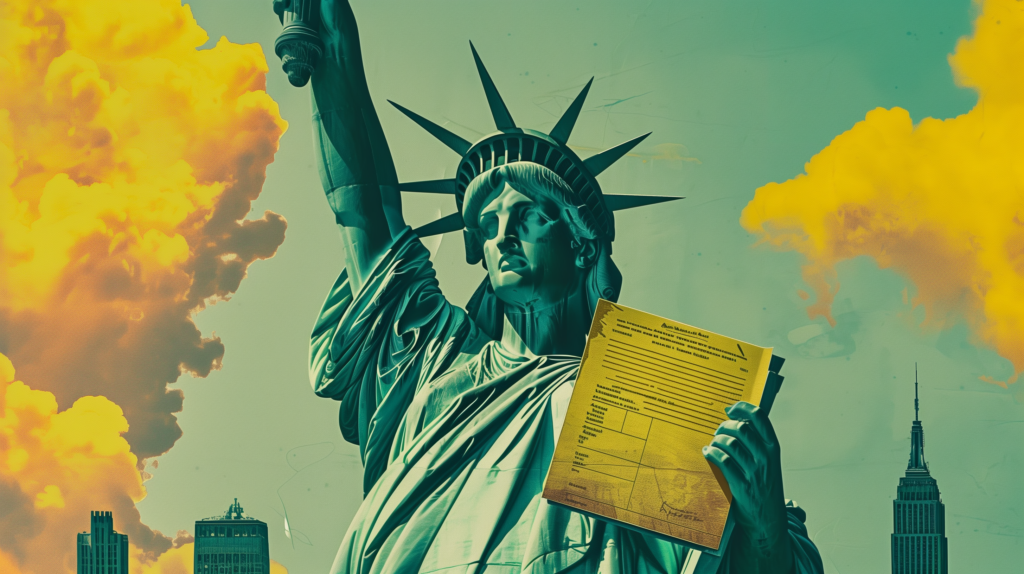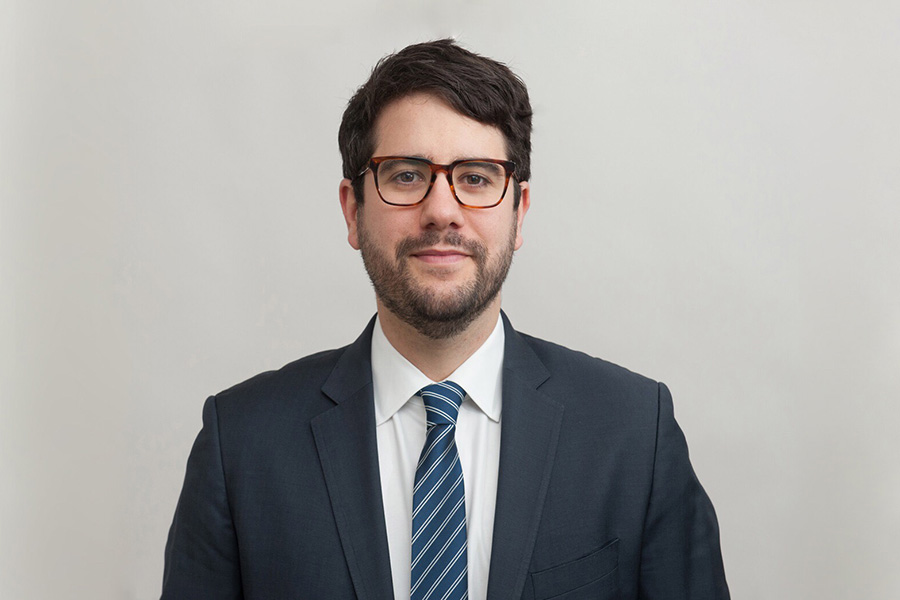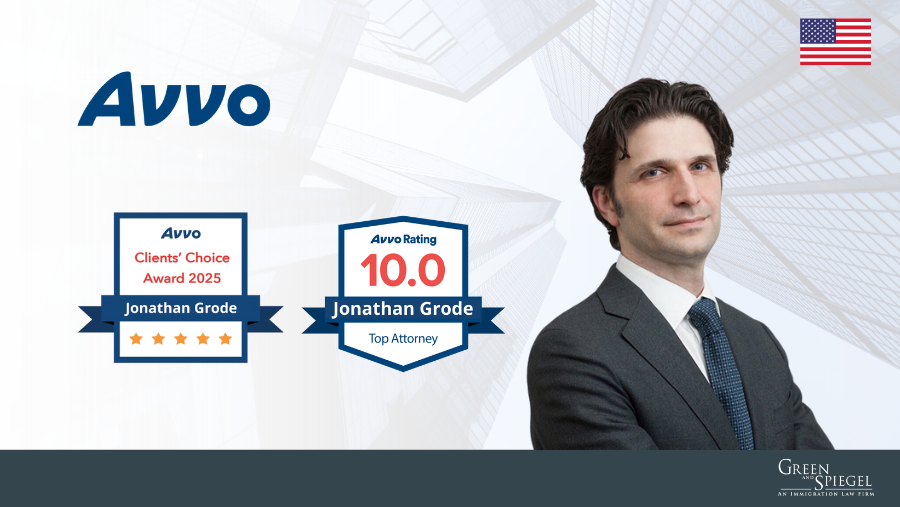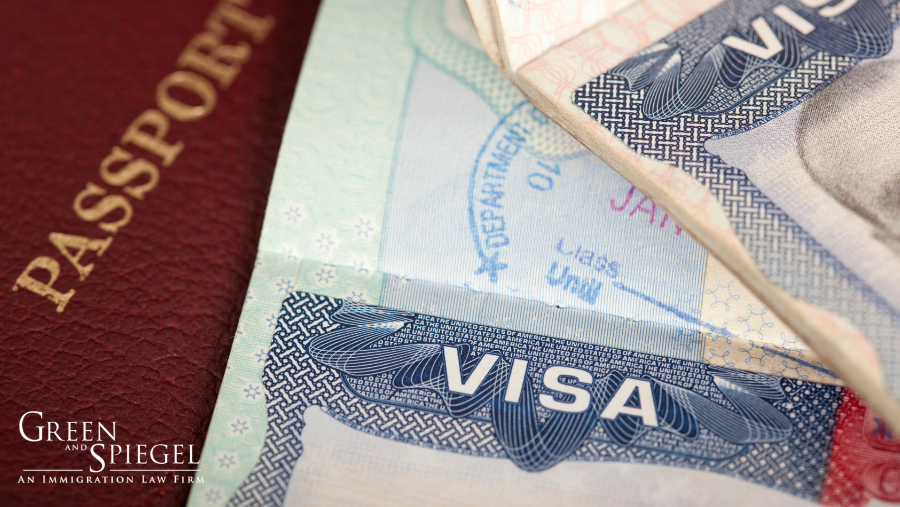Updates to the National Interest Waiver process
For decades, it has not been clear how immigrant experts with advanced STEM degrees could qualify for a National Interest Waiver (NIW) in the permanent residency process. Guidance from U.S. Citizenship and Immigration Services (USCIS) published in January 2022 has helped to resolve this uncertainty. For an eligible immigrant, the NIW can now serve as the most efficient way to secure petition approval, allowing a future application for green card status.
This article:
- Explains the new 2022 guidance concerning the NIW for immigrants holding advanced STEM degrees, including the policy imperative for the guidance,
- Lays out an updated approach to NIW petitions that immigration lawyers have found successful
- Assesses outcomes of the NIW guidance so far.
Key takeaways:
- New USCIS guidance in 2022 clarified how NIW petitions are adjudicated for advanced STEM talent in critical and emerging technology fields.
- National Interest Waivers can now afford qualified recipients an employment-based green card that can be self-sponsored (avoids tying the immigrant to a specific employer), less expensive, more quickly prepared, and more quickly adjudicated than a traditional employment-based green card.
- The new guidance should inform how practitioners assemble petitions for qualifying talent.
- Early figures suggest the number of NIW petitions has more than doubled since the guidance, shifting the share of petitions filed for advanced STEM degree holders toward NIW.
Technology competition and the National Interest Waiver
The NIW has its origin in the Immigration Act of 1990. The Act created a new Employment-Based Second Preference (EB-2) for green cards and the EB-2 sub-category of advanced-degree professionals, or individuals with exceptional ability, who might be granted a waiver of the normal requirement of a job offer and a Labor Department-approved Application for Permanent Employment Certification (PERM) when “in the national interest.” As appropriate for departments and agencies implementing such legislation, legacy INS (Immigration and Naturalization Service, part of the Department of Justice) and, since 2003, USCIS (which is part of the Department of Homeland Security) have identified the contours of the NIW provision by promulgating notice and comment regulations and by issuing precedent decisions through agency adjudications.
The 1990 Act was passed when the U.S. population was three-quarters of its current size, when the real GDP of the U.S. economy was half of what it is today, and before the “STEM” acronym became a standard reference at the National Science Foundation in the early 2000s. When the NIW concept was created, policymakers were not focused on clarifying the circumstances in which scientists, technologists, and engineers with advanced degrees were working in the national interest. The 2022 policy guidance resolves that blind spot by clarifying existing binding regulations and controlling precedent implementing the NIW statute. The new guidance creates increased consistency in adjudicating immigration petitions on behalf of international STEM experts who are now critical players in our economic and technology competition.
The 2022 Policy Manual update did not expand the scope of the NIW. Instead, it simply explained to agency adjudicators, STEM experts, and their employers how the NIW applies to advanced STEM degree holders in critical and emerging technology fields. These degree holders are among the risk-takers the United States has long welcomed as immigrants looking for the best and fastest returns on their own human capital investment. There is no workforce where these dynamics are more important than in the sciences and engineering. Since World War II, it has been clear that this workforce is fundamental to invention and technological adoption, and therefore critical to a nation’s security as well as to growth in opportunity and productivity.
The 2022 clarifying guidance may be viewed as an attempt to address this reality: American technological leadership relies on STEM experts making contributions to research and development (R&D) across government, academia, and industry. R&D benefits from collaboration across sectors and within clusters, where organizations can cross-pollinate one another by exchanging ideas, applications, and talent. The United States excels in this cross-pollination. On a per-capita basis, the United States still leads the world in the number of high-intensity science and technology clusters, those regions with high science and technology employment. Moreover, the U.S. STEM R&D ecosystem is constantly evolving — for instance, industry’s contribution to STEM R&D has grown enormously, from 44% in 1953 to over 73% in 2024. America’s innovation ecosystem is healthiest when STEM experts have the flexibility to follow science wherever it takes them. For a foreign-born STEM expert, that flexibility can be afforded by an approved NIW EB-2 petition.
In some ways, the 2022 NIW clarifications in the USCIS Policy Manual reflect the national interests at play in the growing strategic competition between the United States and China. Many national security experts believe the United States can only win this competition by securing and maintaining a technological lead, and that this can only be done by effectively tapping into the global supply of STEM talent. China already produces twice as many STEM master’s graduates as the United States, and will soon produce twice as many STEM PhD graduates. China has recently surpassed the United States in total science and technology activity according to the Global Innovation Index. With a bigger population and more STEM experts, China could outcompete the U.S. STEM ecosystem.
The new guidance was intended to provide new transparency as to how USCIS officers adjudicate NIW requests related to U.S. science, technology, and engineering. As per Volume 6, Part F, Chapter 5, Part D, Section 2 of the Policy Manual — appropriately titled “Specific Evidentiary Considerations for Persons with Advanced Degrees in Science, Technology, Engineering, or Mathematics (STEM) Fields” — possession of an advanced degree related to a critical and emerging technology holds particular weight when reviewing each of the three prongs of an NIW analysis:
The three prongs of an NIW analysis:
- Is the beneficiary engaged in an endeavor in the national interest?
- Is the beneficiary poised to make contributions to that endeavor?
- Would the United States thus benefit in the beneficiary’s case even without the labor market test usually required for employment-based immigrants?
Specifically, the Policy Manual update clarifies evidentiary considerations that inform whether an NIW is appropriate for certain advanced STEM degree holders whose degrees relate to a “critical and emerging technology field,” as defined by the Executive Office of the President via either the National Science and Technology Council or the National Security Council.
The list of “Critical and Emerging Technologies” periodically updated by the Executive Office of the President includes 18 fields of particular importance (and more than 100 subfields), as of February 2024:
| Fields of Particular Interest | |
|---|---|
| Advanced Computing | Advanced Engineering Materials |
| Advanced Gas Turbine Engine Technologies | Advanced and Networked Sensing and Signature Management |
| Advanced Manufacturing | Artificial Intelligence |
| Biotechnologies | Clean Energy Generation and Storage |
| Data Privacy, Data Security, and Cybersecurity Technologies | Directed Energy |
| Highly Automated, Autonomous, and Uncrewed Systems (UxS), and Robotics | Human-Machine Interfaces |
| Hypersonics | Integrated Communication and Networking Technologies |
| Positioning, Navigation, and Timing (PNT) Technologies | Quantum Information and Enabling Technologies |
| Semiconductors and Microelectronics | Space Technologies and Systems |
Furthermore, USCIS expanded Premium Processing in January 2023 to include NIW petitions, allowing petitioners to secure a decision within 45 business days for an extra fee, versus 10-12 months under normal adjudication times.
With this new NIW Policy Manual update, many highly-educated and accomplished foreign nationals in STEM fields now recognize they have a relatively hassle-free option to secure their futures in the United States. USCIS data released in January 2024 show a more than two-fold increase in the use of NIW by employers that have typically sponsored EB‑2 immigrants in STEM, suggesting that the NIW policy update has informed businesses if not educational institutions on green card strategies for highly valued employees. In fiscal year 2019, the last pre-pandemic year before DHS was developing the new guidance in 2021, there were 59,100 EB-2 petitions filed for beneficiaries in STEM, with 9,260 as NIW. In fiscal year 2023, the first full year after DHS announced the new guidance in January 2022, there were 53,960 EB-2 petition filings for beneficiaries in STEM, with 20,950 as NIW. As such, the proportion of STEM EB-2 NIW filings for STEM experts shifted from around 16% to 39% of the overall STEM EB-2 receipts.
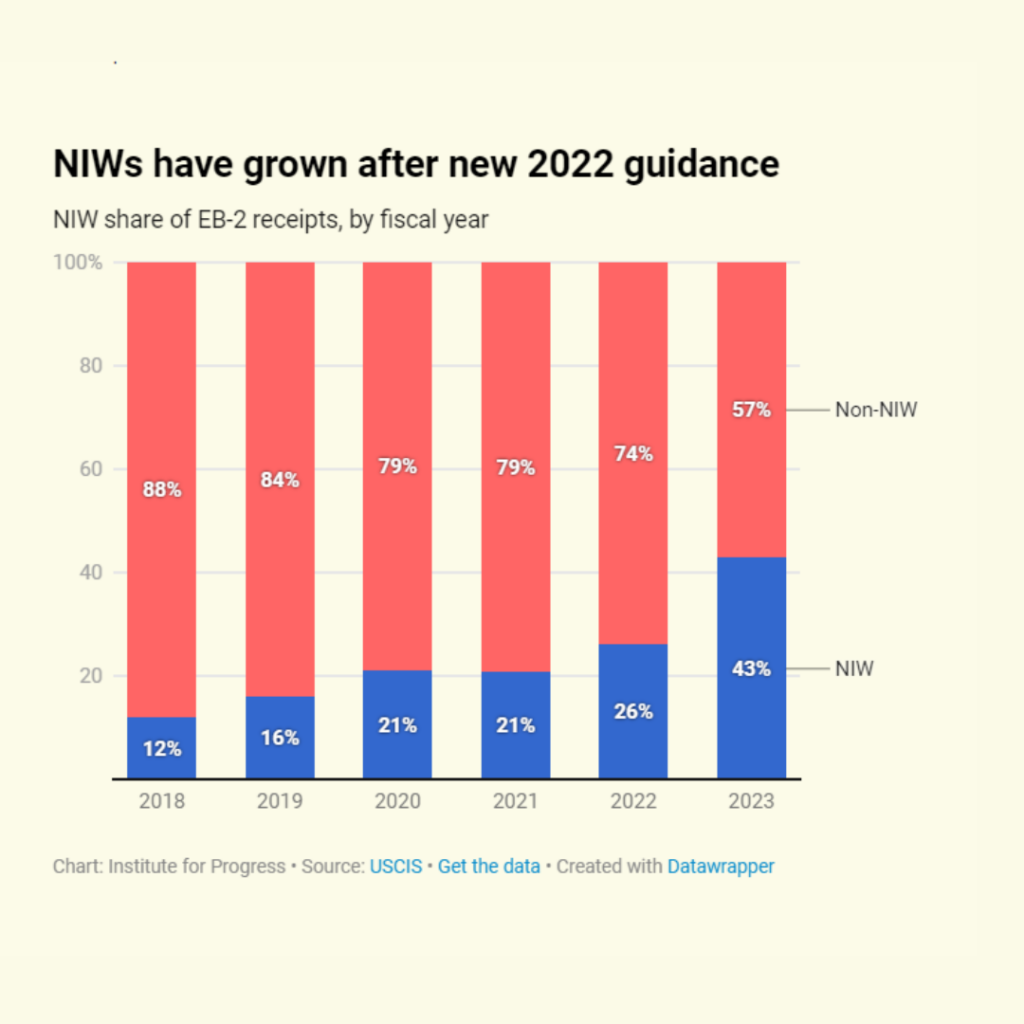
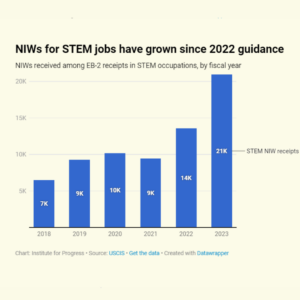
A new approach to NIW petitions
Prior to the January 2022 Policy Manual update, most experienced immigration lawyers perceived little distinction between a petition for NIW EB-2 and a petition for Employment-Based First Preference Extraordinary Ability (EB‑1A). Even though the EB-1A category is meant to recognize individuals who have risen to the very top of their field — which has never been the standard for NIWs — practitioners most often inferred that USCIS adjudicators treated both petition categories interchangeably. As a result, most lawyers prepared both NIW and EB-1A filings with similar levels of supporting detail, using extensive evidence, lengthy letters of support from experts, and complex explanations about the foreign national’s work and significant accomplishments to convey the prominence of the foreign national in their field. The new guidance now clarifies the distinctions between the two categories. A beneficiary does not need to have already risen to the very top of their field to qualify for an NIW. Instead, beneficiaries must be in a position to advance an endeavor of substantial merit and national importance.
The new guidance suggests a new approach to constructing NIW petitions. This article’s co-authors in private practice — Jonathan Grode and Joshua Rolf — set out to test an updated approach to preparing and submitting NIW petitions for STEM masters and PhD graduates.
The attorneys prepared a test group of cases for candidates all holding STEM PhDs. Through filing a batch of cases with similar academic backgrounds, the co-authors hoped to understand whether a STEM PhD in a critical and emerging technology field would carry enough evidentiary weight with a brief description of the beneficiary’s research area, contributions, and employment to result in a positive outcome in most cases. Ultimately, each of these test cases for STEM PhDs was approved promptly, within 60 days before premium processing and two weeks after premium processing, and without Requests for Evidence (RFE).
Although this first group of cases prioritized NIW candidates with PhDs, this approach has been applied in the last year to master’s-level STEM experts working in areas vital to the national interest, especially areas where engineers play a critical role and the terminal degree is at the master’s level. Many individuals leading innovation and efforts to solve complex problems in critical and emerging technologies are engineers, who, when pursuing graduate study, opt for an engineering master’s degree instead of a graduate research degree that terminates with a doctorate, and then work in industry. Foreign nationals with impressive contributions who hold master’s degrees have succeeded in satisfying the three-prong NIW analysis due to their education and area of expertise.
Taken together, these results point to the enormous promise of NIW petitions for immigrants as a self-sponsored employment-based green card that is relatively speedy, inexpensive, and efficient. Another advantage of this increased efficiency is that the petition may be prepared in a matter of days or weeks and then adjudicated within weeks, securing an earlier priority date. The resulting time saved is significant, considering that an NIW could be an alternative to counting on the H-1B lottery for a bridge status to permanent residency. Moreover, PERM can take longer than 18 months to be completed, can present challenges when major industries have layoffs, and features delays in securing a priority date. Given the enormous green card backlog, this significantly affects application wait times for individual immigrants and their families.
NIW petitions present opportunities for employers as well. In a competitive job market, employers are increasingly looking for ways to attract and retain top-level STEM talent. They may look to the NIW as an attractive route for workers seeking a long-term solution to their immigration situation in the United States. In a STEM job market where a significant percentage of job applicants and employees are STEM-educated immigrants, immigration benefits can make the difference in attracting and retaining sought-after talent. The efficiency of the NIW process and the relative ease with which it can be used by applicants in future positions in their field make it an attractive part of an employer’s immigration program, especially if the employer builds a record of success for NIW workers who can reliably qualify for this benefit based on the merit, scope, and importance of their work with the employer, as well as the credentials that qualified them for the role in the first place.
Moreover, an employer offering NIW-qualifying work often may feature economies of scale: an employer can identify pockets of scientific work within its company or institution that are connected to the national interest. In this context, the employer is well-positioned to explain the work the employee (and their similarly-situated colleagues) has done within the industry to contribute to the advancement of its critical technological work, thereby enabling the employer to systematically prepare and apply for an NIW petition for people within that sector of the work. A comprehensive explanation of the work being performed and why it is in the national interest, as well as supporting documentation from company leaders and experts, can be used as supporting evidence in the petitions of all similarly situated applicants. While every petition must contain employee-specific information connecting the foreign national’s specific qualifications, the cross-applicability of information related to specific areas of technology can create efficiencies not typically available in other employment-based petitions. These efficiencies may include saving the significant monetary costs associated with the individualized PERM process for attorney’s fees, recruitment, and applicant review.
When considering a new approach to NIW petitions, practitioners should note that the NIW Policy Manual update specifically references other objective measures of when an endeavor is in the national interest, beyond the government’s “Critical and Emerging Technologies List,” such as when the endeavor is in an R&D-intensive industry, when it is a priority identified annually by the OMB and OSTP Directors in the President’s budget, or when an interested federal agency confirms its national importance.
Although the NIW Policy Manual update specifically reiterates the value of a PhD in the context of a national interest waiver, the guidance also recognizes that STEM master’s degree holders can qualify in certain situations. The authors are optimistic that NIW petitions for STEM master’s graduates will be predictably adjudicated favorably where the individual’s experience before petition filing is in a critical and emerging technology field, and strong evidence shows she is well-positioned to contribute to a specified area in such a field.
In this light, any such NIW program building should also avoid over-extending the classification to individuals with little beyond a STEM master’s degree or PhD on their resume, even if those degrees are in a critical and emerging field. Given the tendency of some beneficiaries, employers, and immigration practitioners to test the limits of new policy guidance, we may see more EB-2 denials in the NIW category, as a proportion of overall EB-2 denials, than in the past. For comparison, in 2019, USCIS denied 990 STEM EB-2 petitions, with 320 (32%) of those denials seeking NIW EB-2 classification. However, by fiscal year 2023, after the new guidance was issued and NIW classification petitions swelled, 90% of STEM EB-2 denials were for those seeking NIW classification (2,120 out of 2,400). The new guidance indicates a successful new approach can yield significant benefits for the right beneficiaries conducting the right kind of work. Nevertheless, the authors encourage caution. It remains just one tool in the toolbox for advanced STEM degree talent. It is not appropriate for all cases, and should not be treated as a universal remedy.
Whether working in a STEM field or otherwise, the NIW is only open for professionals with graduate degrees (or individuals who can document exceptional ability, or a bachelors plus five years of progressive experience in the field) who are also poised to advance particularized endeavors that can be characterized as in the national interest. In addition, as with all immigration adjudications, there is some level of subjectivity and discretion involved. There is therefore always the possibility of baffling or inconsistent decisions, even when new Policy Manual guidance attempts to flesh out details and examples. Of course, misapplication of this approach can backfire, as USCIS over-corrects through increased pushback via Requests for Evidence (RFEs) and denials.
Lessons for immigration law practitioners
The NIW Policy Manual update is an integral part of recent international STEM talent initiatives designed specifically to support U.S. economic and national security interests, which will continue to rely on emerging technologies. In light of the growing need for STEM talent, it provides STEM experts and their employers and counsel with clear, citable guidance. More employers and their counsel should offer the NIW approach to qualified advanced degree holders, while monitoring USCIS backlogs and the Visa Bulletin to continue making informed and strategic decisions for each case. More should also test the boundaries of NIW approach. But, like all good experimentation, it must be done with careful consideration to ensure consistent and scalable results.
